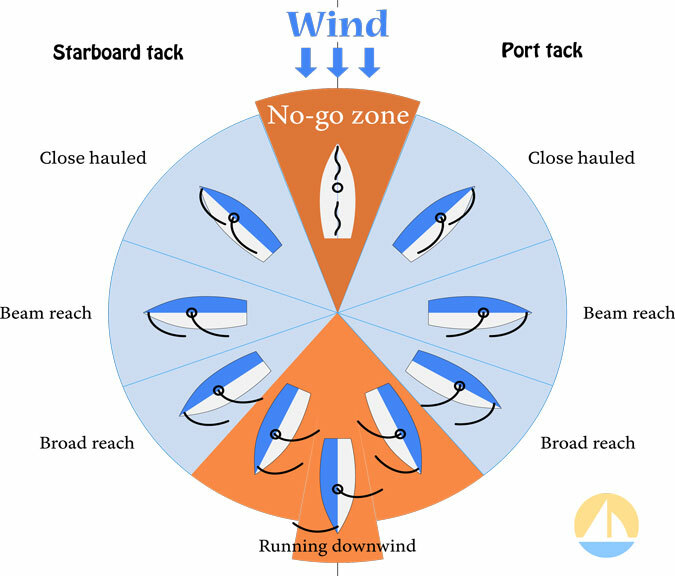The points of sail are the angles of attack in which a sailboat (and its sails) positions itself to the wind. There are primarily five points of sail, only one of which that paralyzes a sailboat from its ability to sail, which is called "In Irons". Memorizing the 5 terms are less important than understanding the concepts. As a beginner, it can be difficult to comprehend how to adjust the sails to the points of sail when sailing, however once you get out of the water and feel how it works, it will all make sense. In the meantime, below is a detailed explanation of how each point of sail works.
The 5 Points of Sail

No-Sail Zone
Each point of sail, including the no-sail zone, or no-go zone as some call it, serves an important purpose when it comes to sailing. In fact, a sailboat will always start and end with the no-sail zone when hoisting up and down the sails. In order to get the mainsail up, there can not be any direct force (from the wind) hitting the mainsail, otherwise the mainsail will become stuck. Trying to hoist the mainsail up and down when not in the no-sail zone runs the risk of damaging your sails and rigging.
Directing into the no-sail zone is easy. Simply determine where the wind is coming from and head directly into the wind, bow first. You'll know when you are sailing directly into the wind when your sails are luffing (flapping back and forth uncontrollably).
Close Hauled
Sailing close hauled is when your vessel is sailing closest to the wind. Many sailboats, such as sloops, sail their best when sailing close hauled. When sailing close hauled, you will always be sailing upwind as your sails are trimmed in as tight as possible - acting as wing generating maximum lift. Tacking, a maneuver that sailors use when zig zagging to a point of interest, is used when sailing close hauled to a destination.
Beam Reach
A beam reach, whether on a starboard or port tack, is when the vessel is directly horizontal to the oncoming wind. The beam (of the mainsail) is opened at a wider angle and the head sail is luffed out more so than when in the close hauled position. Mostly all sailboats are able to sail very well in this position. If the wind changes, the person at the helm can easily adjust the sails in this position without having to tack.
Broad Reach
A broad reach is sailing with the wind (to your backside) at an angle. Sailing in this position, a sailboat will have its mainsail beam opened to the port or starboard side at an angle of about 45 degrees and will have its forward sail (jib) almost completely luffed out. The helmsman always needs to be attentive when reaching due to the possibility of an accidental tack if the wind changes suddenly. An accidental tack will cause the beam of the mainsail to violently swing to the opposite side which can be very dangerous to anyone in its path.
Running
Running downwind is when the wind is coming directly from behind. It would seem as though that this sailing position would be the easiest to sail in, however it's by far the trickiest to maneuver - especially if the sailboat is not equipped with the proper rigging and sails. The tricky part is knowing what do to with the headsail as the mainsail is very simple - just let it all the way out.
A sailboat's standard jib will not be enough to sail sufficiently when running downwind. A sailboat will need two important components when sailing downwind:
- A Spinnaker - An oversized headsail that is hoisted up to the top of the mast and connected at the bottom to a spinnaker pole and sheeted through to a winch.
- and a Spinnaker Pole - A non-fixed miniature beam that connects to the clew of the spinnaker or genoa and attaches itself to the mast at beam level. This piece of equipment hold the sail in place and keeps it from luffing.